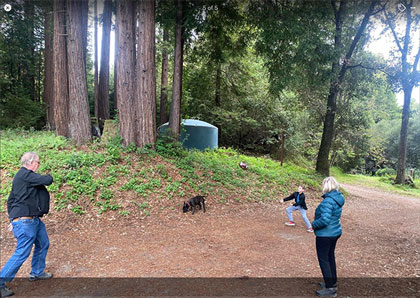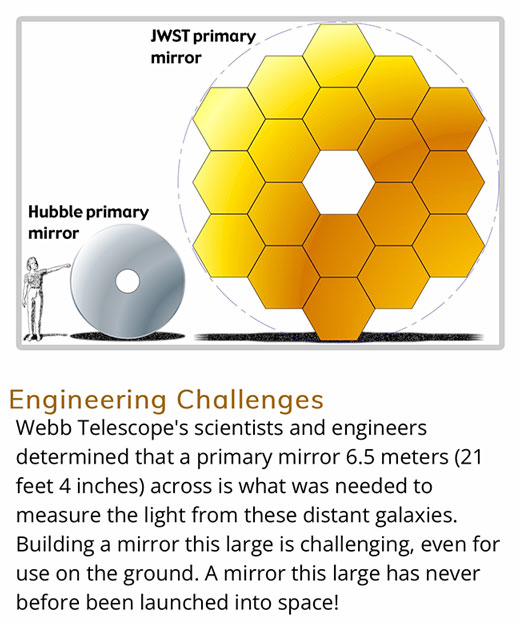Greetings from Palmia Observatory
Well, we were excited to discover that Astronomer Assistant Willow returned to the observatory. We also report on a little travel to northern California and some other online space related news,
First up, Resident Astronomer Peggy was surprised when Willow had crept back inside through the open door that we left open, hoping that she would find her way home. Great, she is back! She is very skinny, but seems healthy and not too dehydrated after being outside in the wild for 12 nights. Here she is claiming her position with Astronomer Assistant Ruby looking on, each trying to get Resident Astronomer Peggy's attention.
 |
| Hooray! Astronomer Assistant Willow is back home! (Source: Palmia Observatory) |
So, we took a little road trip up to Santa Cruz area and stopped at the forest home of Great Nephew, Jack, 10 years old. It was great to see everyone now that everyone is more comfortable with our pandemic safety assessment and Jack asked if I would help him practice throwing and catching the football. Well I always wanted to be physicist wannabe, not a football player wannabe, but I said sure, it would be fun and a pleasure, especially being in such a beautiful forest setting.
 |
| Resident Astronomer practices football passing with Jack (Source: I. D.) |
Well, it wasn't more than 10-15 minutes of practice, that I got a little aggressive in trying to catch one of Jack's returns and as I reached for the ball, I slipped on the forest floor and landed flat on my face. It wasn't Jack's fault as I had forgotten that my balance is now not what it was.
The lens in my glasses popped out and I was bruised and bloodied, but I still managed to smile as we returned to the hotel for bandages and clean up. So here I am while I as waiting for Resident Astronomer Peggy to return from Rite Aid with a glasses repair kit and some big bandages and Neosporin. Besides after procuring a couple of martinis my spirits were back to normal even if my facial image caused a few raised eyebrows as we went in and out of stores and restaurants.
 |
| After diving attempt to catch the football; Why am I smiling? (Source: Palmia Observatory) |
Finally, it was time to leave our forest adventure and on the drive back we stopped at one of the fudge stores on the 5 Fwy home. Here I tried to tempt "Marilyn" with some fudge, but she did not pay any attention to the treat.
 |
| Stopping for favorite fudge near Lost Hills and tempting "Marilyn" Source: Palmia Observatory) |
Now back in the observatory we found a great video on the latest alignment image from the JWST and here Dr. Becky explained what causes the star diffraction spikes. Most small telescope users, using the reflector type of scope, notice diffractions spikes in some of the stellar images. It turns out six of the JWST spikes are caused by the segmented nature of the telescope mirror and the two shorter spikes are caused by the support structure for the secondary mirror. Nonetheless, the image shows good detail of background galaxies and shows the calibration of the JWST is on schedule.
 |
| Sharp JWST image with diffraction spikes explained (Source: Dr. Becky) |
It was also time to take a look at the online version of the Low Cost Science Mission Concepts for Mars Exploration. The workshop was conducted live in Pasadena, but I elected to just attend the online version rather than drive up to Pasadena.
 |
| Could have been here in person, but elected to do it online (Source: hou.usru.edu) |
In this screenshot you can see some of the audience at the workshop Hey, do you recognize Math Whiz, Dave, in the audience? Yep, he elected to go up to Pasadena for some in person workshop participation. Where's Dave?
 |
| Watched online, but Math Whiz Dave was there (Source: hou.usru.edu) |
One of the presentations that caught my attention was by Julianna Scheiman, SpaceX Senior Manager for NASA Launch Services. She discussed some of the features of the new Super Heavy booster and Starship, while Elon has proposed to return manned flights to the Moon and then on to Mars.
This separate size comparison by NextBigFuture shows how the Starship combo compares in size to the SpaceX Falcon 9 and the Saturn V, which took astronauts to the moon. Note how the Starship is taller than the Saturn V.
 |
| Size comparison between Falcon 9, Starship and Saturn V (Source: NextBigFuture.com) |
The JWST segmented mirror is 6.5 meters in diameter when it is fully unfolded. The segmented design was required in order for the telescope when folded up to fit within the Ariane 5 rocket fairing, which can only accept a payload of 5.4 meters in diameter.
 |
| JWST mirror at 6.5 meters compared to Hubble mirror (Source: web.nasa.gov) |
Now, I have been following SpaceX Starship development for sometime now and the Starship is 9 meters in diameter. The size of the payload doors has not be released yet, but it sure seems that the Starship could take payloads of something close to 9 meters in diameter. The actual design details of Starship are not available, but many of the amateur followers of SpaceX development in Boca Chica, TX, have prepared some pretty elaborate detailed sketches of what if might look like. Check out this sketch with internal details by NEOPORK.
 |
| Anatomy of a Starship with 9 meter fairing (Source: NEOPORK, 2021) |
In the meantime, the development of the super heavy booster and Starship is ongoing at SpaceX operations in Boca Chica, TX. I have been down there three times now and am anxiously awaiting the first orbital flight of the Starship from there. The booster and Starship prototypes have undergone some cryogenic propellant testing and the Starship has performed an actual static fire of its engines.
This screenshot from LabPadre shows booster #4 and Starship #20 near the Orbital Launch Tower and Table. Some additional details and testing are still being worked out and the FAA environmental approval to launch the orbital rocket is now delayed until the end of April. There are other prototypes in the production facility and it is not clear which of the prototypes will actually make the orbital attempt. Hope all goes well and we can see this giant step to returning to the moon and Mars being tested and launched. Keep your bags nearly packed and we can go on a moments notice!
 |
| At Starbase in Boca Chica, Starship prototypes stand by for testing (Source: LabPadre) |
Lastly, Science Squad and Part-time Las Vegan, Ken, sent us a YouTube video showing some artistic imagination of how the first 10,000 days of manned occupation of Mars might unfold. It's pretty fanciful, but hey, with Elon aiming for Mars, it might just be close to reality. The video shows the projected flights to Mars including how many robots and real live passengers and accounts for some staying for more than two years and so the number of Martians keeps increasing all through the 10,000 days. Thanks for that Ken! You can check out the video at: https://www.youtube.com/watch?v=G3hPH_bc0Ww
 |
| First 10,000 days on Mars (Source: Venture City) |
Until next time, be sure to attend the APS April Meeting, in person in NYC, or online for me, on April 9-12,

No comments:
Post a Comment